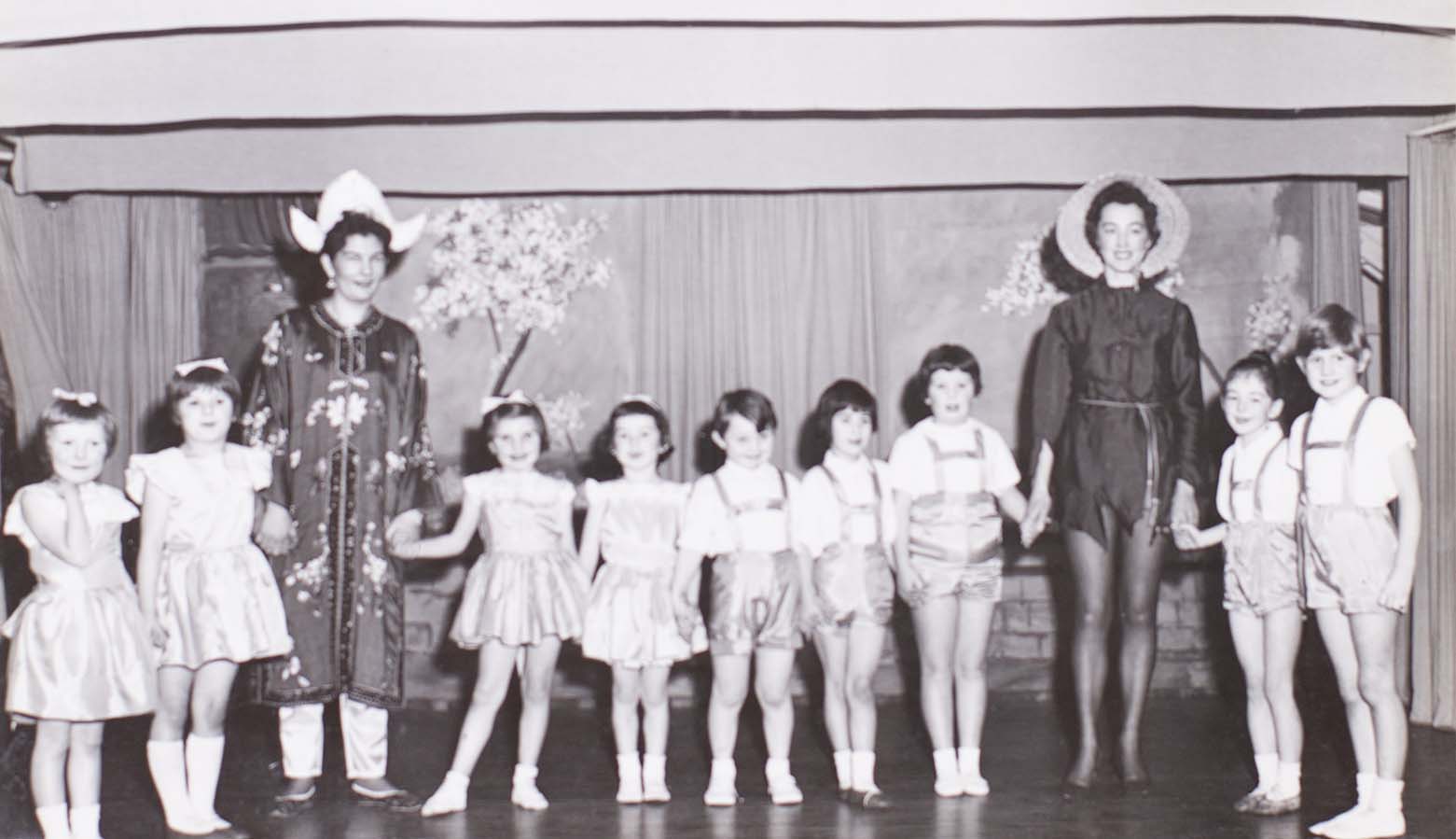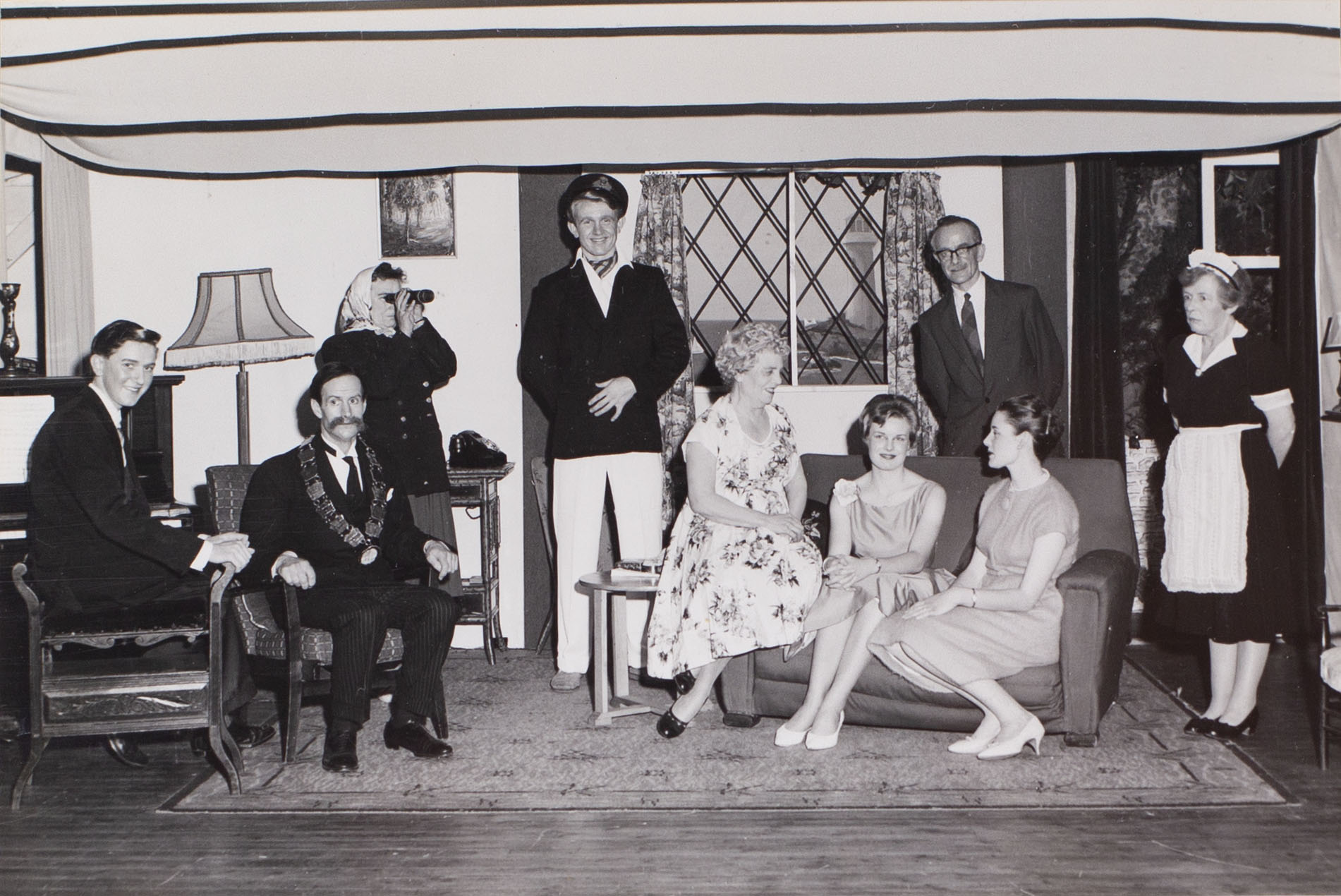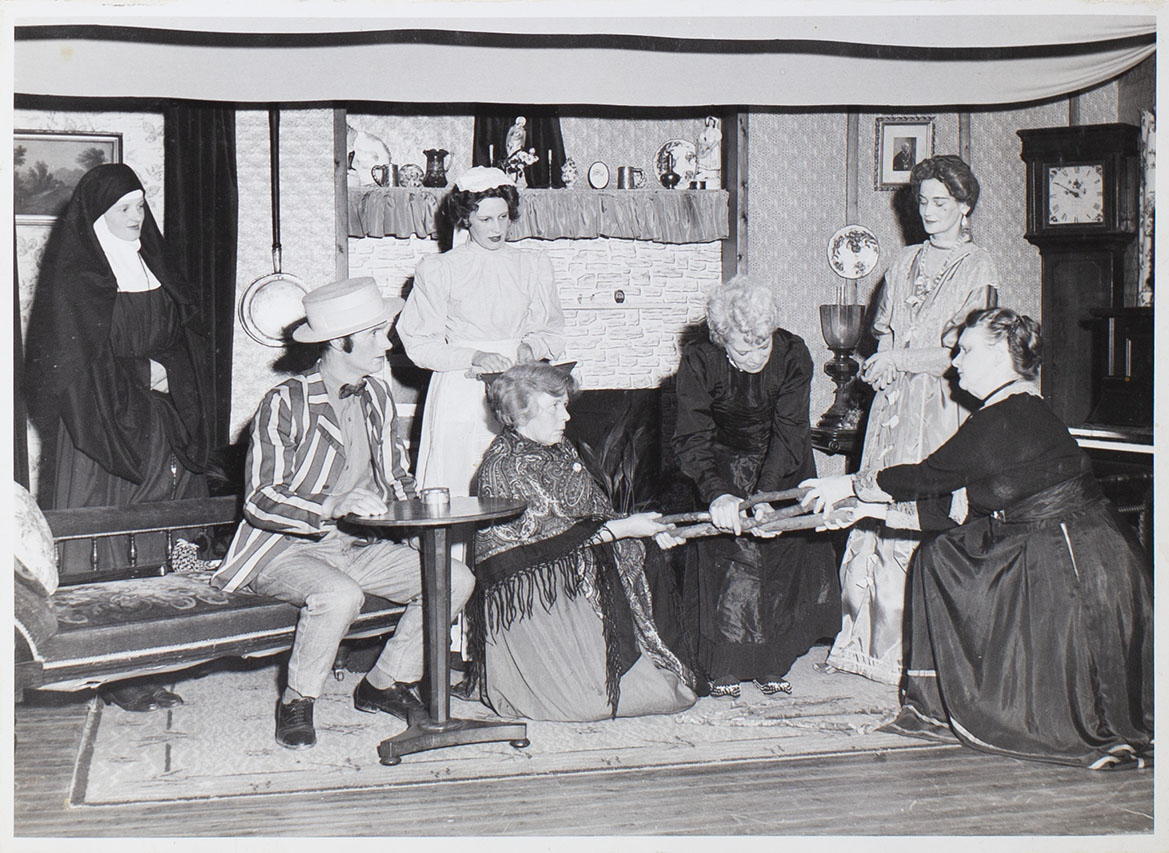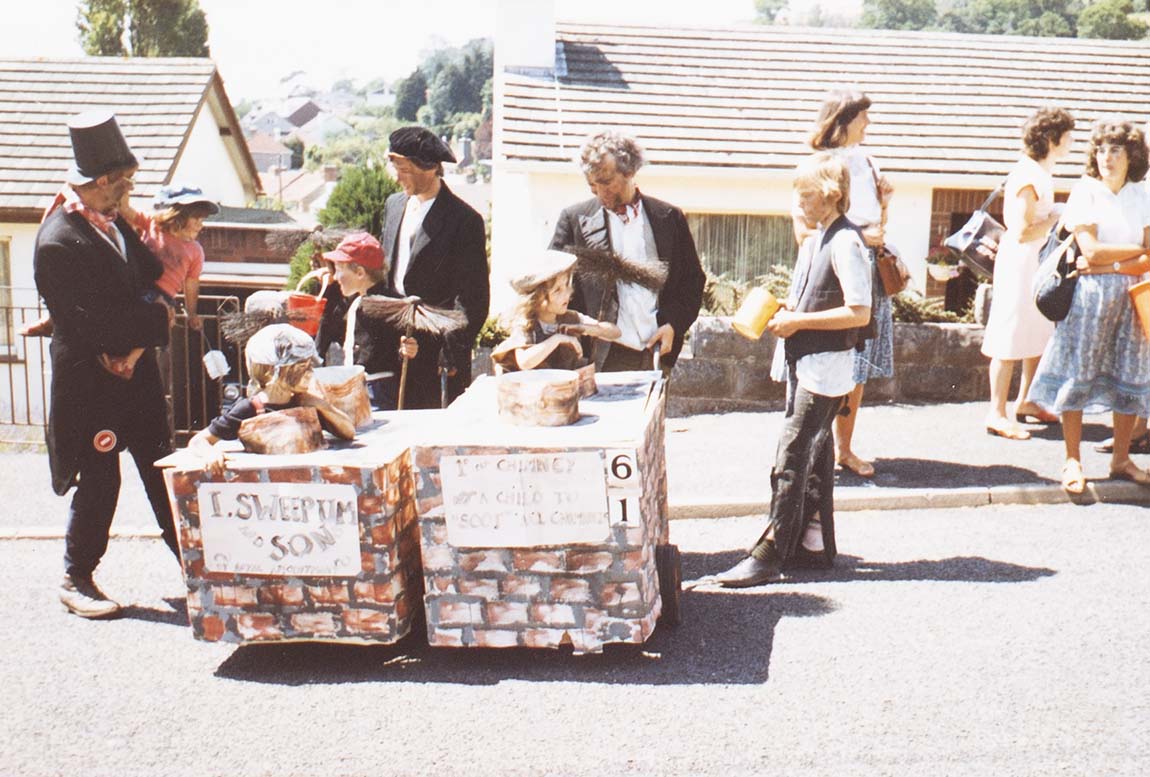In the cottage on the opposite side of Dove’s (grocery shop) lived Mr and Mrs Northam. Mrs Northam was well known for her ‘Devonshire Readings’ (stories spoken in old Devon dialect). The village hall would be full when she was appearing. As a child, I remember the adult audience roaring with laughter. At a young age, I could not appreciate the humour. By the way the grown-ups were reacting, I think the dialogue was probably a bit on the cheeky side.
There were many activities in the village hall, a few times a year was a 1/- dance which included a cup a tea and if you were lucky, a biscuit as well. I can remember a couple of times dancing to Evelyn Hardy’s all girl band dance band. The five women were brilliant. Many of us had attended ballroom lessons in the village hall.
One of the most memorable evenings was by Phil Gourd and William Dawe (known as Duggie), who put on a French evening. With the hall appropriately decorated, there was singing and dancing, some ‘Can-Can’ girls and for a little extra, one could buy a snail in garlic butter.
Before the hall was modernised and the stage was at the opposite end to where it is now ‘Greenwoods Circus’ did a couple of performances on the old stage. It included a couple of goats and dogs. Dorothy, their daughter appeared in a ballet style outfit. All one can say is that it was different.
The village hall was also used on a regular basis for Whist and Beetle drives, both very popular among the grown ups.
It was here when I was about 9 years old that my mother put me to tap dancing classes with ‘The Barbara Spencer Edward School of Dancing’ several older girls also attended. I loved the sound of tap. At that time, there were many famous male tap dancers like Fred Astaire and Sammy Davis Jnr. As we did not have TV until about 1961, we mostly learned of these people if we saw them at the cinema. It was later that I learned from (Granny) Small how the gypsy men also did a form of tap dancing with hard shoes on a wooden board, brilliant to both see and hear.
My main claim to fame while tap dancing was ‘The dance of the Tin Soldier’ dressed in red tunic and busby. I performed this in Bishopsteignton with a group of tap-dancing girls and then singly at Teignmouth ‘Den Pavilion’ which was the name prior to The Carlton and prior to The Pavilions and lastly in the theatre at the end of the pier. That was my lot, I had, had enough of the tin soldier by then.
“I was no longer little and cute….”
I did continue with Barbara Spencer Edwards at her studio in Teignmouth but not dancing, for a short while I changed to acrobatics. I gave it up when I started at senior school for it was at ‘Teign Lawn’ secondary modern school that instead of football, which I was useless at, I was encouraged by Mr Williams (PE and Maths teacher) to spend the time training in gymnastics, which I really enjoyed. The school had an incredible modern gymnasium with all the equipment anyone would need.
Sometimes Roy Lucas from Bishopsteignton, (practice and relief teacher) would be there to help. The time spent dancing and acrobatics, although seen by some as a sissy activity for a boy, it had strengthened my muscles and kept my body flexible as well as helping me with balance, a real must for gymnasts. It was many, many years later that I understand dance moves were being included as an important exercise feature for many sports.
The village hall became the home of Bishopsteignton Players, I was in a couple of productions and we had a fundraising variety night, which was good fun. Those of us that performed the twist on stage were told that as far as was known at that time, we were the first known group to dance the twist in formation.
From the very first meeting held at Colonel and Mrs Rooth’s home on Radway Street, right from the word go, the passion and enthusiasm was there to ensure its success. It was fun and a lot of hard teamwork, first nights were nerve wrecking. Those early days were a challenge as we had nothing to measure success by, but we did have a lot of support from the village and everyone mucked in. I feel honoured to have been part of that very first meeting.
There were also many activities out and around the village. There was a very well supported Bowling Club, my father and three uncles played regularly. The bowling green was in the centre of the village, behind Central Garage in Fore Street. It was an immaculate green and there were bowls teams from around the district, which mainly played games on a Saturday afternoon. Sometimes in the summer, there were evening matches.
The bowlers were dressed in uniform and always wore sandals or soft shoes. Children were never allowed near or on the green, the adults were very strict about that, so the family never passed on the art of bowling.
As children, we used to say,
“We were not allowed to play as it was game for old men with sore feet”.
There were four or five of us that enjoyed playing tennis although at that time it was considered more of an upper class sport. Occasionally the owners of Tapley Hotel would let our group use the court in their grounds. It was not often used and was beginning to show its age but to us it was great. In our minds, we played world-class tennis. With no TV to measure our performance, we relied on dad’s newspaper, radio & cinema newsreels.
The village carnival was always great fun and we all readily joined in. One year we cubs were all dressed and made up as clowns with Sheila (Akela) as the ringmaster. Mrs Thompson’s little dog was also on the lorry with us, wearing a ruff round his neck. Another year my brother John was Prince Charles as a youngster, in a royal pageant portraying Queen Anne and Queen Victoria. Another time my uncle Lewis and (uncle) Johnny were part of a group of men dressed in long style granny clothes and playing music and called themselves, ‘The Gannie-dears Band’. My mother and (auntie) May Mole blacked up with burnt cork and appeared as two Caribbean women. Many people from Kingsteignton attended our carnivals and in turn, many Bishopsteignton people supported the Kingsteignton Ram Roasting Fair. Sometimes at the carnival, the queens from other village carnivals would visit. The atmosphere was incredible.
The ‘British Legion Fete’ held at Huntly each year, was the highlight for many. The garage attached to Huntley, a very large space, was full of tables displaying competition produce of all kinds including crafts, homemade cakes and bread (large and small), jams, marmalade, pickles and chutneys, of every flavour. There were vegetables and flowers of every kind; which had been nurtured to ‘show standard’. The place was a mass of colour and appetising smells.
In the beautiful main grounds with sweeping lawns, shrubberies and trees, there was much to see and do with many stalls, children’s games and sports and of course the Maypole Dancing. There was time for the older ones to relax and have a cup of tea and just watch all the activities in comfort. My Dad, (uncle) Ted Livermore and (uncle) Maurice Ledger (these three were work mates), did the washing up in a tin bath and then drying of hundreds of plates, cups and saucers each year. Sometimes Mr Witheridge would help. It was a wonderful day with most of the village turning out.
The Bishopsteignton people were proud of its links with the British Legion and locally were very active. Apart from the fete, there were many other activities during the year, generally held in the village hall. From a very early age, we were brought up to respect the British Legion and all it stood for.
Mrs Langworthy who for many years while I was growing up; was the Bishopsteignton British Legion colour bearer. She and her daughter Mrs Beare always looked splendid in their uniforms, so smart and everything exactly as it should be. One year my mum was proud to be one of the members to go to the Royal Albert Hall, Festival of Remembrance.
As a family, we always attended the Remembrance Day tribute starting at the War Memorial and marching down to the church for the Remembrance Day service. One year I had the honour of carrying the scout colours. For many years, Tom Crispin stood proudly on the War Memorial and played the bugle “The Last Post” summoning everyone to silence. Tom lodged with Nurse Lucas, near Huntley. Everyone attending were in uniform, suits or best Sunday clothes.
The church fete; held in the gardens at the Vicarage opposite the church was also a very popular event. The gardens seemed enormous and one could look around the ground floor of the vicarage. It was a beautiful building but for a small child it was difficult to understand how three people could live in such an enormous building. The whole of our house would have fitted in a couple of rooms in the vicarage, but that was a child’s thought’s which lasted just a fraction of a minute as it was more important to join the ice cream queue.
PC Lake our village policeman would always be there and be part of the parade leaders. He was well respected and knew everyone in the village. He, his wife and two lovely ‘show’ dachshunds lived in one of the houses at West Town Meadow. As well as the Remembrance service, PC Lake would always be in uniform outside the church for every wedding and funeral, not as it were on duty, but showing respect. He did a lot extra outside of his professional role e.g. We would take a few cubs at a time to the local telephone call box and ring PC Lake, He would then ask questions and test the individual cubs until, he was satisfied they could use the telephone both socially or in an emergency. This was in the days of A and B buttons and feeding the phone with pence.
Colin’s reminiscences are continued in 2 more parts, visit Born and Raised in Bishopsteignton to read more.
Thank you to Colin Back for his stories and to him and Rowena Bradnam for the images.
This article was assembled by Dawn Rogers and the Bishopsteignton Heritage Hub Team.
In the cottage on the opposite side of Dove’s (grocery shop) lived Mr and Mrs Northam. Mrs Northam was well known for her ‘Devonshire Readings’ (stories spoken in old Devon dialect). The village hall would be full when she was appearing. As a child, I remember the adult audience roaring with laughter. At a young age, I could not appreciate the humour. By the way the grown-ups were reacting, I think the dialogue was probably a bit on the cheeky side.
There were many activities in the village hall, a few times a year was a 1/- dance which included a cup a tea and if you were lucky, a biscuit as well. I can remember a couple of times dancing to Evelyn Hardy’s all girl band dance band. The five women were brilliant. Many of us had attended ballroom lessons in the village hall.
One of the most memorable evenings was by Phil Gourd and William Dawe (known as Duggie), who put on a French evening. With the hall appropriately decorated, there was singing and dancing, some ‘Can-Can’ girls and for a little extra, one could buy a snail in garlic butter.
Before the hall was modernised and the stage was at the opposite end to where it is now ‘Greenwoods Circus’ did a couple of performances on the old stage. It included a couple of goats and dogs. Dorothy, their daughter appeared in a ballet style outfit. All one can say is that it was different.
The village hall was also used on a regular basis for Whist and Beetle drives, both very popular among the grown ups.
It was here when I was about 9 years old that my mother put me to tap dancing classes with ‘The Barbara Spencer Edward School of Dancing’ several older girls also attended. I loved the sound of tap. At that time, there were many famous male tap dancers like Fred Astaire and Sammy Davis Jnr. As we did not have TV until about 1961, we mostly learned of these people if we saw them at the cinema. It was later that I learned from (Granny) Small how the gypsy men also did a form of tap dancing with hard shoes on a wooden board, brilliant to both see and hear.
My main claim to fame while tap dancing was ‘The dance of the Tin Soldier’ dressed in red tunic and busby. I performed this in Bishopsteignton with a group of tap-dancing girls and then singly at Teignmouth ‘Den Pavilion’ which was the name prior to The Carlton and prior to The Pavilions and lastly in the theatre at the end of the pier. That was my lot, I’d had enough of the tin soldier by then!
“I was no longer little and cute….”
I did continue with Barbara Spencer Edwards at her studio in Teignmouth but not dancing, for a short while I changed to acrobatics. I gave it up when I started at senior school for it was at ‘Teign Lawn’ secondary modern school that instead of football, which I was useless at, I was encouraged by Mr Williams (PE and Maths teacher) to spend the time training in gymnastics, which I really enjoyed. The school had an incredible modern gymnasium with all the equipment anyone would need.
Sometimes Roy Lucas from Bishopsteignton, (practice and relief teacher) would be there to help. The time spent dancing and acrobatics, although seen by some as a sissy activity for a boy, it had strengthened my muscles and kept my body flexible as well as helping me with balance, a real must for gymnasts. It was many, many years later that I understand dance moves were being included as an important exercise feature for many sports.
The village hall became the home of Bishopsteignton Players, I was in a couple of productions and we had a fundraising variety night, which was good fun. Those of us that performed the twist on stage were told that as far as was known at that time, we were the first known group to dance the twist in formation.
From the very first meeting held at Colonel and Mrs Rooth’s home on Radway Street, right from the word go, the passion and enthusiasm was there to ensure its success. It was fun and a lot of hard teamwork, first nights were nerve wrecking. Those early days were a challenge as we had nothing to measure success by, but we did have a lot of support from the village and everyone mucked in. I feel honoured to have been part of that very first meeting.
There were also many activities out and around the village. There was a very well supported Bowling Club, my father and three uncles played regularly. The bowling green was in the centre of the village, behind Central Garage in Fore Street. It was an immaculate green and there were bowls teams from around the district, which mainly played games on a Saturday afternoon. Sometimes in the summer, there were evening matches.
The bowlers were dressed in uniform and always wore sandals or soft shoes. Children were never allowed near or on the green, the adults were very strict about that, so the family never passed on the art of bowling.
As children, we used to say,
“We were not allowed to play as it was game for old men with sore feet”.
There were four or five of us that enjoyed playing tennis although at that time it was considered more of an upper class sport. Occasionally the owners of Tapley Hotel would let our group use the court in their grounds. It was not often used and was beginning to show its age but to us it was great. In our minds, we played world-class tennis. With no TV to measure our performance, we relied on dad’s newspaper, radio & cinema newsreels.
The village carnival was always great fun and we all readily joined in. One year we cubs were all dressed and made up as clowns with Sheila (Akela) as the ringmaster. Mrs Thompson’s little dog was also on the lorry with us, wearing a ruff round his neck. Another year my brother John was Prince Charles as a youngster, in a royal pageant portraying Queen Anne and Queen Victoria. Another time my uncle Lewis and (uncle) Johnny were part of a group of men dressed in long style granny clothes and playing music and called themselves, ‘The Gannie-dears Band’. My mother and (auntie) May Mole once appeared as two Caribbean women. Many people from Kingsteignton attended our carnivals and in turn, many Bishopsteignton people supported the Kingsteignton Ram Roasting Fair. Sometimes at the carnival, the queens from other village carnivals would visit. The atmosphere was incredible.
The ‘British Legion Fete’ held at Huntly each year, was the highlight for many. The garage attached to Huntley, a very large space, was full of tables displaying competition produce of all kinds including crafts, homemade cakes and bread (large and small), jams, marmalade, pickles and chutneys, of every flavour. There were vegetables and flowers of every kind; which had been nurtured to ‘show standard’. The place was a mass of colour and appetising smells.
In the beautiful main grounds with sweeping lawns, shrubberies and trees, there was much to see and do with many stalls, children’s games and sports and of course the Maypole Dancing. There was time for the older ones to relax and have a cup of tea and just watch all the activities in comfort. My Dad, (uncle) Ted Livermore and (uncle) Maurice Ledger (these three were work mates), did the washing up in a tin bath and then drying of hundreds of plates, cups and saucers each year. Sometimes Mr Witheridge would help. It was a wonderful day with most of the village turning out.
The Bishopsteignton people were proud of its links with the British Legion and locally were very active. Apart from the fete, there were many other activities during the year, generally held in the village hall. From a very early age, we were brought up to respect the British Legion and all it stood for.
Mrs Langworthy who for many years while I was growing up; was the Bishopsteignton British Legion colour bearer. She and her daughter Mrs Beare always looked splendid in their uniforms, so smart and everything exactly as it should be. One year my mum was proud to be one of the members to go to the Royal Albert Hall, Festival of Remembrance.
As a family, we always attended the Remembrance Day tribute starting at the War Memorial and marching down to the church for the Remembrance Day service. One year I had the honour of carrying the scout colours. For many years, Tom Crispin stood proudly on the War Memorial and played the bugle “The Last Post” summoning everyone to silence. Tom lodged with Nurse Lucas, near Huntley. Everyone attending were in uniform, suits or best Sunday clothes.
The church fete; held in the gardens at the Vicarage opposite the church was also a very popular event. The gardens seemed enormous and one could look around the ground floor of the vicarage. It was a beautiful building but for a small child it was difficult to understand how three people could live in such an enormous building. The whole of our house would have fitted in a couple of rooms in the vicarage, but that was a child’s thought’s which lasted just a fraction of a minute as it was more important to join the ice cream queue.
PC Lake our village policeman would always be there and be part of the parade leaders. He was well respected and knew everyone in the village. He, his wife and two lovely ‘show’ dachshunds lived in one of the houses at West Town Meadow. As well as the Remembrance service, PC Lake would always be in uniform outside the church for every wedding and funeral, not as it were on duty, but showing respect. He did a lot extra outside of his professional role e.g. We would take a few cubs at a time to the local telephone call box and ring PC Lake, He would then ask questions and test the individual cubs until, he was satisfied they could use the telephone both socially or in an emergency. This was in the days of A and B buttons and feeding the phone with pence.
Colin’s reminiscences are continued in 2 more parts, visit Born and Raised in Bishopsteignton to read more.
Thank you to Colin Back for his stories and to him and Rowena Bradnam for the images.
This article was assembled by Dawn Rogers and the Bishopsteignton Heritage Hub Team.
















